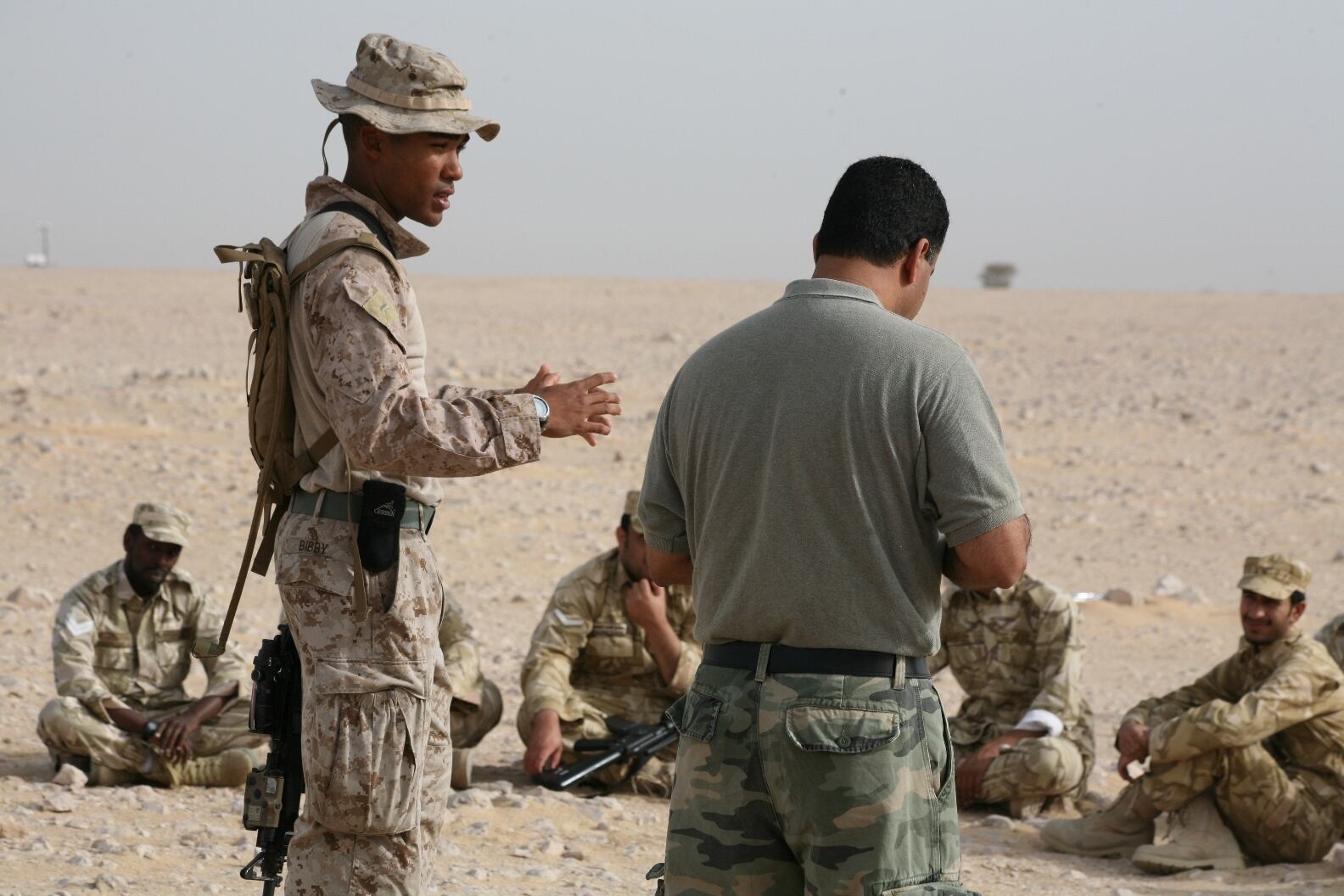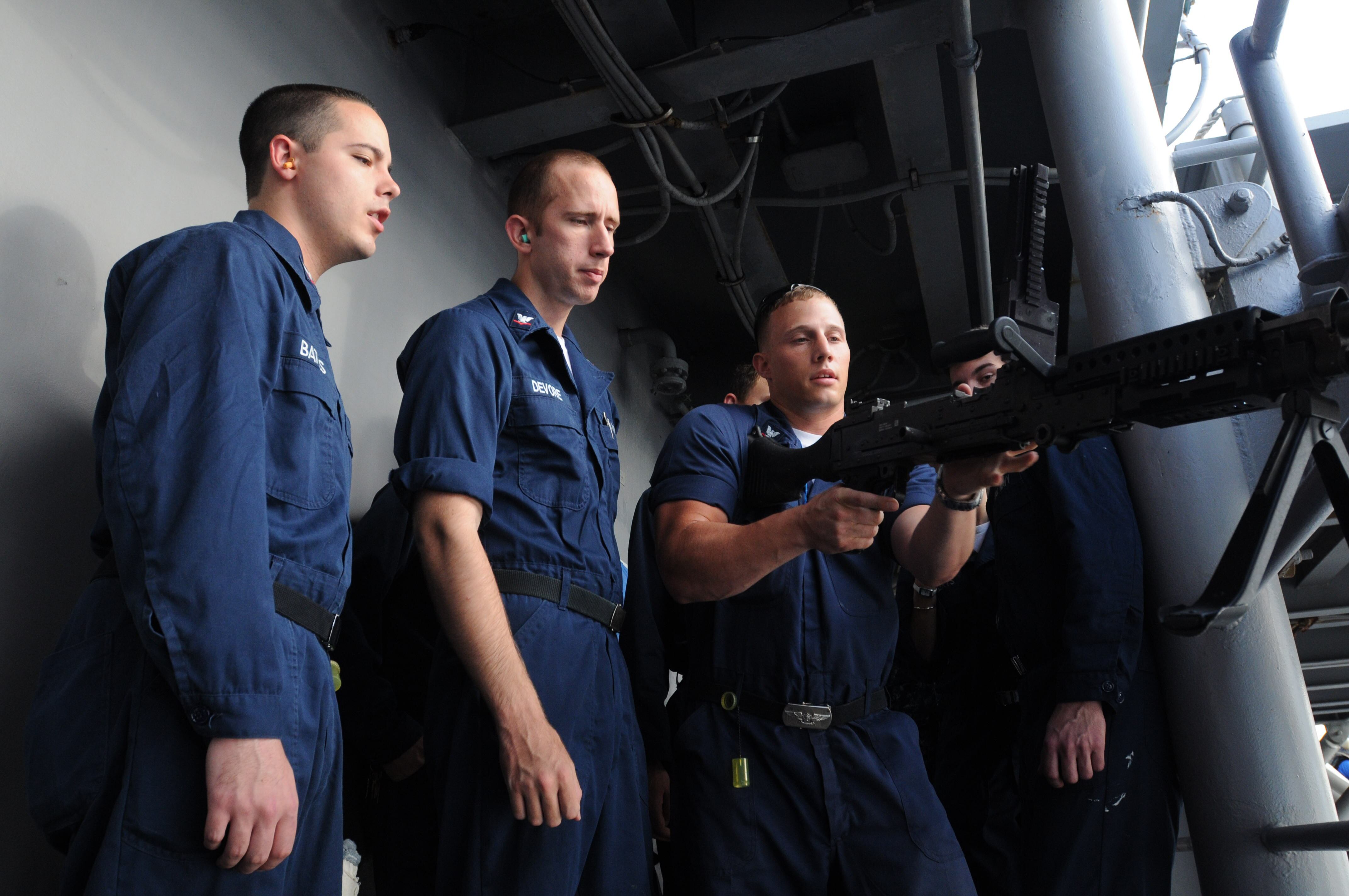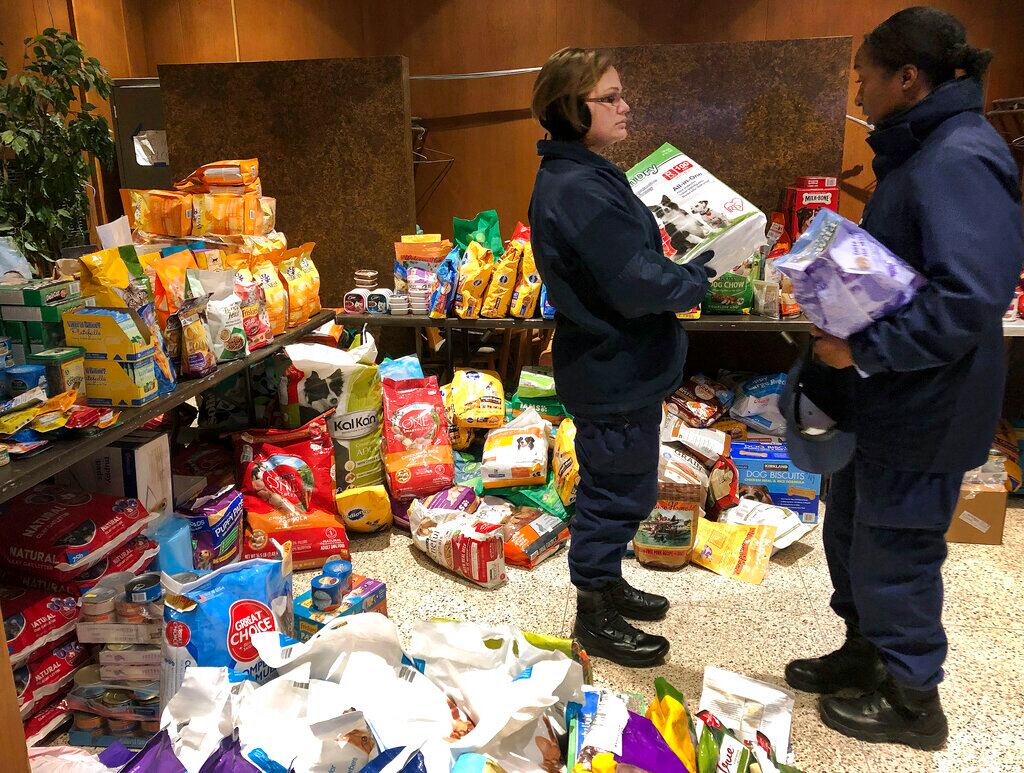Editors Note: This article first appeared on The War Horse, an award-winning nonprofit news organization educating the public on military service. Subscribe to their newsletter.
When Kyle Bibby reported in to the Naval Academy, he had never fired a gun. But he learned to shoot a pistol. Then a rifle. He learned safety measures and effective training. Eventually, he taught pistol to other midshipmen. When he graduated and was commissioned as an infantry officer in the Marine Corps, he says, “Pistols, rifles, machine guns, rockets — that was my life.”
Then he became a civilian.
“I am a gun owner, myself,” Bibby says. “And I just remember constantly feeling like, Oh, that’s it? I just show up, and you just hand it to me. There’s no safety manual. There’s no, ‘Hey, I recommend you do this. Hey, do you got a safe place to lock it?’

“Nope. Just, ‘Here’s this thing that can kill you or anyone else.’”
After yet another school shooting — one that, even as people grieved, caused the usual forays against politicizing tragedy or offering “thoughts and prayers” rather than solutions — veterans continue to speak up, on social media, in organizations they have formed, and in the media.
Some veterans are tired of being seen as homogenous, decked in T-shirts that feature big guns, voting based purely on the idea that you will take their weaponry only from cold, inflexible fingers.
Veterans have issues of their own with guns, violence, and suicide. They also know veterans are “just people” — often “just people” who haven’t trained on a weapon in decades — rather than heroes simply waiting for the Bat-Signal so they can instantly appear in schoolyards across the United States.
They want to help swing the argument back to a conversation about practical solutions, to a place where people can listen to each other and pay attention to the wants and needs of the majority rather than those who use service members and veterans to push a single-note story. They want to help a grieving nation understand that they, too, are diverse in their ideas, backgrounds, and opinions, but they take pride in their ability to work together.
They’re ready to be the good guys with guns, but maybe those guns are kept in a locked box in the garage. Or maybe the good guys with guns are required to train at the range every year to keep their weapons. Or maybe they have to go through a background check to buy them.
“The veteran space is a really interesting space to talk about gun control, because amongst veterans, just like most issues, there’s a lot of different opinions,” Bibby says. But, “we know what it’s like to hand an 18-year-old who has very little life experiences a very deadly weapon.”
There have been 27 school shootings so far this year, a number that seems to need daily updating. And there have been 119 since 2018, according to Education Weekly. Gun violence has risen in general: For the first time, children died more often from guns than in car accidents in 2020, The Washington Post reports. Kids have higher access to guns, too, and that increase has led to higher rates of suicide, according to the Society for Research in Child Development.
In May, a gunman shot into a crowd at a music festival in Oklahoma, killing one and injuring seven. There were no doors to defend, to lock. Six people were shot in downtown Chattanooga, with the mayor calling them “kids”: teenagers with access to guns. In Buffalo, a man killed 10 people at a grocery store because they were Black.
The veterans say the conversations can’t keep ending in a stalemate, and the solutions — or the beginnings of them — might be right there for everybody to see.

“As an individual soldier, I’ve gone through robust training, and as a company commander, when I oversaw soldiers, we have a training program for them to ensure range safety and firearm safety, as well,” says Anthony Joyce-Rivera, who serves as a major in the U.S. Army but spoke on his own behalf and not for the U.S. government. “And on military installations, there is no — I do not carry a firearm, I’m not allowed to carry a firearm. If I owned a weapon — full disclosure, I do not own a personal firearm — but if I did, the post requires you to have it registered with the provost marshal, and it has to be under two-lock security at all times in the home.”
He has never heard anyone complain about the policy, he says. But as a father of three young boys, and as the spouse of a woman who earned a degree because she plans to be a school teacher, he’s troubled by the lack of action around the issue.
He thought a lot about the shooting in Texas.
“All the things that were in place,” he says. “The police were, theoretically, at the scene at the time of the shooter showing up, so this ‘good guys with guns’ — they were there. Did they do anything in time? The gap to respond was frustrating; seeing the parents in the videos pleading for people to go in and do something, and being restrained, is very troubling and hard to see. Because I can empathize if that were my child in that school and I was a parent outside. …”
‘We have very strict regulations’
“Gun control” isn’t a foreign concept for service members.
“In the military, we have very strict regulations over safe weapons handling and storage of weapons,” says former Marine Joe Plenzler, an avid shooter since childhood who competes and likes to shoot at ranges. “For instance, on base, all weapons are stored in the base armory. They are prohibited from being stored in on-base residential areas.”
Plenzler also serves on the Veterans Advisory Council for Everytown for Gun Safety, a group that advocates for gun safety reforms.
The military requires extensive weapons training before anyone’s even allowed on the range: They talk about how to handle weapons. They use weapons simulators. They talk about range procedures.

“When I go in the military, they don’t just hand me a gun, right?” says Fred Wellman, a retired Army officer and political strategist. “You don’t just sign in and go, ‘All right there, Wellman, here’s your M4. And here’s the ammo. Here’s six magazines of ammo. Look, just keep it under your bed.’ No.”
Sherman Gillums Jr., a Marine Corps veteran and long-time veterans advocate, pushes further, saying it’s a misperception that military training is all about guns: It’s about safety and training.
“We don’t hand them a weapon, the day they — a weapon with bullets, I should say — the day they arrive at boot camp,” he told The War Horse. “It takes some time. They’re there for about a month before they ever see ammunition.”
(Disclosure: Gillums serves on the board of directors for The War Horse.)
Before service members get to that point, they face a background check — mental, physical, and criminal — before they join the military, Wellman says. And the rules that follow the checks and the training are strict.
“The weapon is kept in a locked and secured facility where you don’t have access to it,” he says. “Ammo is kept separately from that facility. For me to get my weapon, I have to sign it out. There’s rules that apply. I’m trained on the weapon in every way. If I break those rules, there’s punishment. … We don’t just have guys walk around posts with guns — because it’s stupid.”
Even with those rules in place, the military mandated further precautions to keep service members safe after officials in Iraq reported 126 negligent discharges among American troops in Afghanistan over an eight-month period and at least 90 troops died in Iraq. After years of rising suicide rates as national access to guns increased, Veterans Affairs began a campaign to encourage veterans to lock up their weapons. (Veterans suicide rates decreased in 2019.) And the services insist on continual training because leaders know inexperienced shooters get hurt or hurt others.
But that care is not what civilians see in the fight for gun-access rights: People in military-type gear armed to the hilt with magazines at the ready appear at state capitols, coffee shops, and grocery stores in their push for more access. In fact, it’s hard to know how many of those protestors are truly veterans. Veterans are, after all, known for losing their minds if a service member points a weapon at a pal in a movie, so the idea of a magazine in a rifle at a coffee shop seems out of character.
On most military bases, service members aren’t allowed to carry weapons.
“We require extensive training for service members to handle weapons,” Plenzler says. “We only issue live ammunition under strict supervision and on designated training ranges. This is with the exception of people standing security duty or in combat. I would say the military takes weapons safety and storage very seriously, while the civilian community in America does not.”
‘A particular type of patriotism’
Gun culture in the United States has long been intertwined with the military. Union veterans, concerned about a lack of marksmanship among their troops during the Civil War, founded the National Rifle Association, which met in Houston this Memorial Day weekend. For decades after its formation, the NRA’s rhetoric focused on military readiness — making sure civilians who might be called on to fight for their country knew how to shoot, says Matthew Lacombe, an assistant professor of political science at Barnard College and the author of Firepower: How the NRA Turned Gun Owners into a Political Force. But starting in the 1960s, the focus has shifted away from explicit military preparedness and more toward an ideology of “a particular type of patriotism.”
“I think what has remained is this notion that gun owners are sort of similar to soldiers,” Lacombe says. “They’re the patriotic defenders of our way of life.”
But many veterans say valorizing the military through gun ownership mischaracterizes the military experience.
“I’m a combat veteran four times over, and most of the time I was in Iraq, I spent sitting in rooms, drinking tea, eating sheep, and trying to keep people from killing each other,” Wellman says. “You’re really seeing the use of our veteran experience and the military experience as part of this conversation in ways that are troubling. But what’s troubling is that the majority of veterans who commit suicide do so by weapon.”
To continue the politicization of the military community, in the immediate aftermath of the Texas school shooting, the memes appeared: Just place an armed veteran in front of every school building.

“It’s frustrating because it’s not realistic,” Joyce-Rivera says.
The average veteran served from the ages of 18 to 21, got an honorable discharge, and then went on with their life, he says. Now, at age 48 or so, they haven’t had weapons training in decades. Depending on what their jobs were in the military, they may not have had much to begin with.
“There’s this idea that veterans are somehow mythical humans that make less faulty decisions than other people,” he says.
He reiterated Wellman’s concerns about suicide: “The VA is looking at how to address gun violence for suicides for veterans,” he says. “So is the solution the demographic that already is struggling with suicide through firearms … having [them] equipped with firearms at schools?”
As a national conversation about veterans and mental health grows, Republican lawmakers have repeatedly introduced legislation attempting to protect gun access for veterans, often framing the issue in patriotic terms.
“There are struggles that the veteran community is dealing with of their own through gun violence,” Joyce-Rivera says. “And the mental health crisis? How do we look at that and thoughtfully address it without just saying, ‘Veterans are the solution here’?”

For Gillums Jr., the veterans advocate, the question of veterans and gun access is a complicated one. Any discussion of restricting guns should be part of a broader conversation about mental health care, he says.
But, he says, what he finds intolerable is lawmakers who haven’t served posing with guns as a way of declaring their support for the military.
“You see the fingers on a trigger, all the things that show you clearly know nothing about the military culture,” he says, referring to constant training to touch the trigger only when it’s time to shoot. “The point of joining the military is not to have a weapon.”
Both Wellman and Gillums Jr. say they see hope in veterans in elected office — on both sides of the aisle.
“I do place a lot of the onus right now going forward on the folks in Congress who know what it means, who know what these weapons can do, who have had to fire them, have had to use them to defend the country, and are now in positions of responsibility — not authority, responsibility — to do the right thing,” Gillums Jr. says.
‘An unacceptable calculus’
Given the long string of shootings from Columbine High School to a country music festival in Las Vegas to this month’s shootings in Texas and New York, Kyleanne Hunter, a former Marine, likened America to a war zone — maybe even worse.
“We knew we might not come home and we knew we might have to live with guilt of others not coming home,” says Hunter, of Colorado, who served tours in Iraq and Afghanistan as a Super Cobra helicopter pilot and just finished the school year at the Air Force Academy as a professor of political science. “That’s part of the calculus that you take when you volunteer in an all-volunteer force.”
But Americans shouldn’t expect to face it at home, she says, and the news this month saddened her on a different level: “That is an unacceptable calculus to exist, going to school or going to a concert or going to church or going to a grocery shop.”
Hunter and Plenzler push back against the idea that gun control laws can’t make a difference. They are part of the #VetsForGunReform, a movement made up of veterans across the political spectrum.
“There’s no easy solutions, but there are actionable steps that we could take,” Plenzler says.
Joyce-Rivera has a suggestion:
The military employs weapons systems for a specific purpose, Joyce-Rivera says: To kill enemy combatants. But in the United States, people argue for the right to defend their homes. For that purpose, there should be a different weapons system, he says — one that doesn’t necessarily need to be accurate at 300 meters.

“If the argument is to defend your home, I think we can design weapons systems that fulfill that need, but also help detract against the use of those weapons systems to commit mass shootings and killings,” he says. “As a military guy, that’s kind of where my head’s at is we got to talk about these things as weapons systems.”
The mass shootings aren’t the only violent firearm deaths to think about, Plenzler says. Crimes and suicides, happening in every corner of the country, should also be considered. Nobody he knows has all the answers for how to reverse the trend, Plenzler says, but adds that failing to seek solutions wouldn’t be fair to the victims. And the “false binary choices,” often advanced for political purposes, that people are either pro- or anti-gun complicates the conversation.
“It’s not like we need to be all for no restrictions on guns whatsoever or we’re for complete abolition,” Plenzler says. “I mean neither of those extremes are tenable positions. What I’m really interested in is finding the work in the middle.”
He starts by asking people what would make them feel safer. He often hears support for universal background checks for all gun sales. Many polls, including a survey by Morning Consult and Politico conducted one day after the Texas elementary school shooting, back up his assertion. The poll found 73% of respondents “strongly support” universal background checks and another 15% “somewhat support” the idea.
The House passed the Bipartisan Background Checks Act of 2021 for all gun sales more than a year ago, but the measure has lingered in the Senate.

“I think people are getting tired of having a Congress that is flying in the face of public sentiment,” Plenzler says.
The Morning Consult poll also found that 4% “somewhat” oppose universal background checks and another 4% “strongly” oppose them.
Veterans themselves are “more supportive than nonveterans of expanding civilians’ gun-carrying rights,” according to research published this month in Social Science Quarterly, but are more likely to favor “banning AR15 and military-style rifles and high-capacity ammunition clips.” They’re also more likely to be in favor of a 14-day waiting period for “all gun purchases.”
“Taken together, these findings appear to reflect a veteran population that is positively disposed toward guns in general, but also understands the destructive power of military-style weapons,” the authors wrote.
A new “domestic terrorism” bill, which would have opened debate about hate crimes and gun safety, that flew through the House after the shooting in Texas was blocked when every Republican voted against it when it hit the Senate, saying it didn’t provide enough emphasis on domestic terrorism committed by those on the far left. Right-wing extremists have “been involved in 267 plots or attacks and 91 fatalities” since 2015, The Washington Post reports. Left-wing extremists have been involved in “66 incidents leading to 19 deaths.”
A bipartisan group of Senators is working on a bill that would address background checks for online or gun-show gun purchases, laws that would keep guns away from people a doctor has said could hurt themselves or others, and programs to increase security at schools.
Hunter would like to sit down with those who oppose any limits on gun ownership, she says — especially those who are against any regulations on assault rifles — to ask them if it is “worth it”:
“Is their AR-15 worth the fact that the generation of school kids that are there right now have worse educational outcomes than their parents because they’re afraid of being at school?”
The silence on bipartisan solutions has been the most frustrating point, Joyce-Rivera says.
“We need to address the problem,” he says. “And the problem is children are being killed with firearms.”
This War Horse investigation was reported by Michael de Yoanna, Sonner Kehrt, and Kelly Kennedy; edited by Kelly Kennedy; fact-checked by Ben Kalin; and copy-edited by Mitchell Hansen-Dewar. Headlines are by Abbie Bennett.




